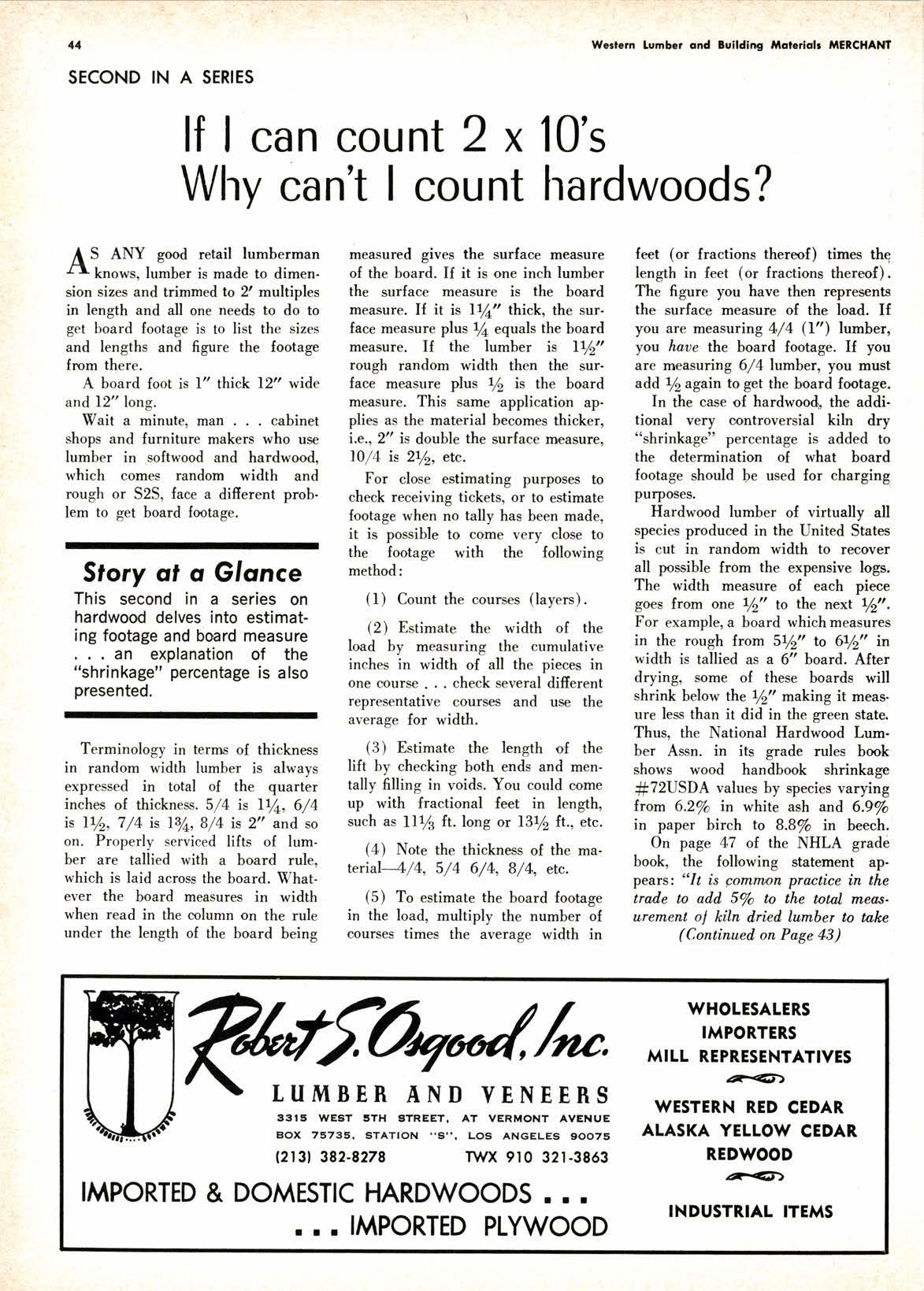
2 minute read
Wlry can't I count lrardwoods?
A S ANY good retail lumberman / r knows. lumber is made to dimension sizes and trimmed to 2' multiples in length and all one needs to do to get board footage is to list the sizes and lengths and figure the footage from there.
A board foot is 1" thick 12" wide and 12" long.
Wait a minute, man cabinet shops and furniture makers who use lumber in softwood and hardwood, which comes random width and rough or S2S, face a different prob. lem to get board lootage.
Story dt d Glonce
This second in a series on hardwood delves into estimating footage and board measure . . an explanation of the "shrinkage" percentage is also presented.
Terminology in terms of thickness in random width lumber is always expressed in total of the quarter inches of thickness. 5/4 is |t/a, 6/4 is l7/2, 7/4 is 13/n,8/4 is 2" and so on. Properly serviced lifts of lum. ber are tallied with a board rule, which is laid across the board. Whatever the board measures in width when read in the column on the rule under the length of the board being measured gives the surface measure of the board. If it is one inch lumber the surface measure is the board measure. II it is ytTnr thick, the surface measure plustTn equals the board measure. If the lumber is lr/2" rough random width then the surface measure plus t/2 is the board measure. This same application applies as the material becomes thicker, i.e,,2" is double the surface measure, lO/4 is 2r/2, etc.
For close estimating purposes to check receiving tickets, or to estimate footage when no tally has been made, it is possible to come very close to the footage with the following method:
(I) Count the courses (layers).
(2) Estimate the width of the load by measuring the cumulative inches in width of all the pieces in one @urse . check several difierent representative courses and use the average for width.
(3) Estimate the length of the lift by checking both ends and mentally filling in voids. You could come up with fractional feet in length, such as llys It. long or lSyz It., etc.
(4) Note the thickness of the material-4/A, 5/4 6/4, 8/4, etc.
(5) To estimate the board footage in the load, multiply the number oI courses times the average width in feet (or fractions thereof) times t\ length in feet (or fractions thereof). The figure you have then represents the surface measure of the load. If you are measuring 4/4 (1") lumber, you haae the board footage. If you are nreasuring 6/4 lumber, you must add 1/z again to get the board footage.
In the case of hardwood'. the additional very oontroversial kiln d.y "shrinkage" percentage is added to the determination of what board footage should be used for charging purpo€es.
Hardwood lumber of virtually all specim produced in the United States is cut in random width to r@over all possible from the expensive logs. The width measure of each piece goes from on" L/2" to the next t/{'. For examplg a board which measures in the rough Irom SYz" to 67/2" in width is tallied as a 6" board. After drying, some of these boards will shrink below the r/2,, making it measure Iess than it did in the green state Thus, the National Hardwood Lum. ber Assn. in its grade rules book shows wood handbook shrinkage #72USDA values by species varying from 6.2/o in white ash and 6.9Vo in paper birch to 8.8/o in beech.
On page 47 oL the NHLA grade book, the following statement ap. pears: "11 is pommon pradice in the trad,e to add SVo to the total measurernent ol kiln dried, Iumber to take
(Continued, on Page 43) r*!t










